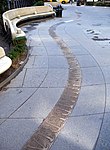75 Wall Street

75 Wall Street is a 43-story mixed-use building in the Financial District of Lower Manhattan in New York City. It contains Hyatt Centric Wall Street New York, a hotel with 253 rooms managed by Blue Sky Hospitality.Designed by Welton Becket & Associates and developed by London & Leeds as an office building, 75 Wall Street was announced in 1984 as the North American headquarters of British bank Barclays. After the building opened in 1987, several firms leased space in the building. JPMorgan Chase acquired 75 Wall Street from Barclays in 2005, and the Hakimian Organization and Peykar Brothers Realty purchased the building later that year. The upper floors were converted to 346 residential condominiums in 2009, while the lower floors opened as the Andaz Wall Street hotel in January 2010. Navika Capital acquired the hotel in 2022 and rebranded it as Hyatt Centric Wall Street New York.
Excerpt from the Wikipedia article 75 Wall Street (License: CC BY-SA 3.0, Authors, Images).75 Wall Street
Pearl Street, New York Manhattan
Geographical coordinates (GPS) Address Nearby Places Show on map
Geographical coordinates (GPS)
| Latitude | Longitude |
|---|---|
| N 40.7051 ° | E -74.008 ° |
Address
75 Wall
Pearl Street
10038 New York, Manhattan
New York, United States
Open on Google Maps








